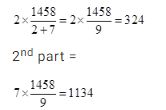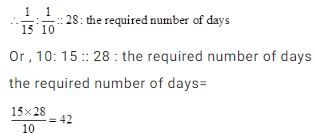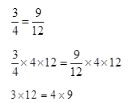Heartfully Presented By
AIMS DARE TO SUCCESS
MADE IN INDIA
⏬Telegram Channel ⬇
https://t.me/AIMSDARETOSUCCESS
💡YouTube Channel 🔗
AIMS DARE TO SUCCESS
https://www.youtube.com/channel/UCm-y_cHY75scDiG67Df62dw?sub_confirmation=1
⌛ Web Sites ⏰
👀 For All Competitive Exams Study Material 👀
https://www.aimsdaretosuccess.blogspot.com
👇 For Mathematics Study Material 👇
https://www.aimsdts.blogspot.com
🔦 For Any Queries 🔭
aimsdaretosuccess@gmail.com
If u want to get FREE Study Material Please Add My number 9440345996 in Your All Groups
Joy of sharing is Caring & Helping
Short Tricks to Solve Ratio & Proportion Problems
To make the chapter easy for you all, we are providing you all some Important Short Tricks to solve Ratio & Proportion Questions which will surely make the chapter easy for you all.
Ratio and Proportion
The number of times one quantity contains another quantity of the same kind is called the ratio of the two quantities.
Observe carefully that the two quantities must be of the same kind. There can be a ratio between Rs.20 and Rs 30, but there can be no ratio between Rs 20 and 30 mangoes.
The ratio 2 to 3 is written as 2 : 3 or 2/3. 2 and 3 are called the terms of the ratio. 2 is the first term and 3 is the second term.
Consequent
In the ratio 2 :3 , 2 is the antecedent and 3 is the consequent.
Note:
(1) The word ‘consequent ’ literally means ‘that which goes after’.
(2) since the quotient obtained on dividing one concrete quantity by another of the same kind is an abstract number, the ratio between two concrete quantities of the same kind is an abstract number. Thus, the ratio between Rs 5 and 7 is 5:7.
Compound Ratio
Ratios are compound by multiplying together the antecedents for a new antecedent, and the consequents for a new consequent.
Ex: find the ratio compound of the ratio:
4:3, 9: 13, 26 : 5 and 2:15
Solution;
The required ratio =
Inverse Ratio
- If 2:3 be the given ratio, then 1/2: 1/3 or 3 :2 is called its inverse orreciprocal ratio.
- If the antecedent = the consequent, the ratio is called the ratio of equality, such as 3:3.
- If the antecedent >the consequent, the ratio is called the ratio of greater inequality, as 4 :3
- If the antecedent < the consequent, the ratio is called the ratio of less inequality, as 3 : 4.
Ex. Divide 1458 into two parts such that one may be to the other as 2: 7.
Solution:
Proportion
Consider the two ratios:
1st ratio 2nd ratio
6 : 18 8 : 24
Since 6 is one-third of 18, and 8 is one –third of 24, the two ratios are equal. The equality of ratio is called proportion.
The number 6, 18, 8 and 24 are said to be in proportion.
The proportion may be written as
6 : 18 :: 8 : 24 (6 is to 18 as 8 is to 24)
Or, 6 :18 = 8:24 or 6/18 = 8/24
The numbers 6, 18, 8 and 24 are called the terms. 6 is the first terms, 18 the second, 8 the third, and 24 the fourth. The first and fourth terms, i.e. 6 and 24 are called the extremes (end terms), and the second and the third terms, i.e., 18 and 8 are called the means (middle terms). 24 is called the fourth proportional.
- If your quantities be in proportion, the product of the extremes is equal to the product of the means.
Let the four quantities 3, 4, 9 and 12 be in proportion.
We have,
- Three quantities of the same kind are said to be in continued proportion when the ratio of the first to the second is equal to the ratio of the second the third.
The second quantity is called the mean proportional between the first and the third ; and the third quantity is called the third proportional to the first and second.
Thus, 9, 6 and 4 are in continued proportion for 9 :6 ::6 :4.
Hence, 6 is the mean proportional between 9 and 4, and 4 is the third proportional to 9 and 6.
Ex1. Find the fourth proportional to the numbers 6, 8 and 15.
Solution:
If x be the fourth proportional, then 6 : 8 = 15:x
Ex2. Find the third proportional to 15 and 20.
Solution:
Here, we have to find a fourth proportional to 15, 20 and 20. If x be the fourth proportional, we have 15 :20 = 20:x
Direct Proportion: consider the following example.
Ex. 1: If 5 ball cost Rs 8, what do 15 balls cost?
Solution:
It will be seen at once that if the number of balls be increased 2, 3, 4,….times, the price will also be increased 2, 3, 4… times.
Therefore, 5 balls is the same fraction of 15 balls that the cost of balls is of the cost of 15 balls.
5 balls : 15 balls :: Rs8 : required cost
the required cost = Rs
15 * 8 / 5
=Rs 24
This, example is an illustration of what is called direct proportion. In this case, the two given quantities are so related to each other that if one of them is multiplied (or divided) by any number, the other is also multiplied (or divided) by the same number.
Inverse Proportion: Consider the following example
Ex. 1: If 15 men can reap a filed in 28 days, in how many days will 10 men reap it?
Solution:
Here, it will be seen that if the number of men be increased 2, 3,4,….times, the number of days will be decreased 2, 3, 4…times. Therefore, the inverse ratio of the number of men is equal to the ratio of the corresponding number 
The above example is an illustration of what is called inverse proportion. In this case, the two quantities are so related that if one of them is multiplied by any number, the other is divided by the same number, and vice versa.
Ex 2: The employer decreases the number of his employees in the ratio 10 :9 and increase their ways in the ratio 11:12. What is the ratio of his two expenditures?
Solution:
The required ratio = 10×11 : 9 ×12 = 55 : 54
Ex3: A vessel contains liquid A and B in ratio 5 :3. If 16 liters of the mixture are removed and the same quantity of liquid B is added, the ratio becomes 3 :5. What quantity does the vessel hold?
Solution:
Quicker Method:
When the ratio is reversed (i.e., 5:3 becomes 3 :5), we can use the formula;
Total quantity =
×Quantity of A in the removed mixture
=
liters.








No comments:
Post a Comment